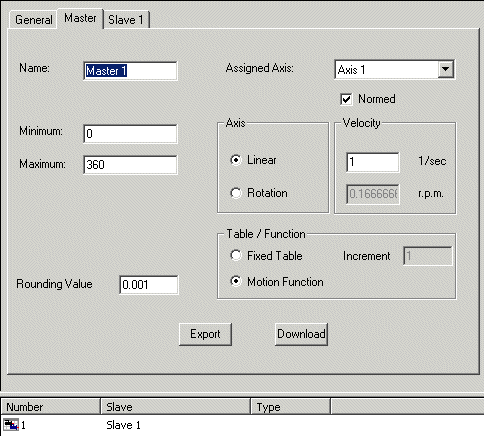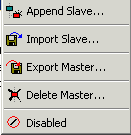The Properties of the Master
The master's property page offers the following facilities:

The minimum and maximum master positions can be specified.
The Normed switch allows you to choose between a normalised display and a physically oriented display in which the velocity, acceleration and jerk of the slave are shown against time. The normalised display refers these displays to the master position.
The velocity of the master is needed for the physically oriented display; it is necessary, first of all, to distinguish here between a linear and a rotary axis (angular values quoted in degrees). When the data is transferred to the NC, the choice between a linear and a rotary axis specifies whether the table type is linear or cyclic.
For a rotary Master, the first and second derivatives at the end are set equal to the corresponding figures at the start of the movement cycle, if the starting and end positions of the slave correspond to the minimum and maximum positions of the master.
The increment specifies the increment of the master position used for output of the table into a file. If an equidistant table is to be generated, the total length (the actual maximum minus the minimum) should be divisible by the increment. When the project is saved in the registry, the information required to generate and transfer the tables with this increment is created in the NC.
Motion Function can be used to transfer the complete slave information to the NC. This means that only the edge points of the segments and the corresponding information, such as the law of motion, are loaded into the NC. The NC then calculates the corresponding slave values (position, velocity and acceleration) for the current master position during runtime. Past problems that had their origin in the discretization of the data in the table essentially no longer exist.
 | Functionalities such as special motion laws that are not yet available in the NC are marked in red in the cam plate editor. These may not be selected. |
The Rounding Value rounds the master position in the graphic input with the given value.
In order to import slaves, a right mouse click on the master in the tree view allows the Import Slave... item from the menu

to be selected.
It is possible here to export the master data, including the slave data. It is possible to import this data via the tree view under the Tables item.